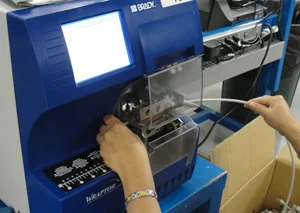Wire markers and cable labeling play an essential role in wire and cable management systems. Beyond that of an organizational tool, marking and labeling are a form of visual communication that offers comprehensive identification of an entire assembly or system. Marking and labeling properly document electrical assemblies or IT networks that can further aid in troubleshooting, solving, or detecting disruptions to infrastructure. It can streamline access to a system for maintenance and repair or facilitate easy connectivity when adding or changing out equipment or hardware to a network. It also ensures compliance with quality assurance standards or regulatory requirements important to workplaces such as offices, warehouses, or any type of manufacturing landscape and production environment.
Choosing the Right Labels
When researching markers and labeling for wires and cables in networks and assemblies, several factors should be taken into consideration in the selection process. These include such factors as a label’s application environment and durability, its material properties, and the actual type of marking that will be required of the application. Even the positioning of your marker or labels should be considered.
Environment
The environment can pose many problems in maintaining markings and labels. When selecting a marker or label, consider the environmental impact of the application. It may be exposed to the elements in all kinds of weather, or the application may be in contact with oil, water, chemicals, grime, dirt, or solvents. If there are special identification requirements related to compliance or regulatory bodies, then it’s imperative that the markings last.
Durability
Durability is a major factor when considering the type of environment, but it also plays an important role in the type of material selected to meet any environmental challenges presented to the markers and labels. In other words, a material’s properties should be guided by the application environment of the marking. For example, if the application is in a high-heat environment, then the material should have self-extinguishing properties. In a wet environment it needs to remain legible, around harsh environments like oil or chemicals the markings should be resistant to such spills.
Material Selection
 Prime materials for markings and labeling would be any class of thermoplastic option that can be formulated to meet any environmental challenges. The largest class of thermoplastics, polyolefins, which includes polyethylene (PE) and polypropylene (PP), have chemical and high-heat resistant properties as well as moisture resistance. Other common thermoplastic materials used in markings or sleeves, are vinyl and nylon. Vinyl offers excellent oil and dirt resistance. The material is also ideal for applications on non-flat sub-surfaces. For applications on curved surfaces, nylon’s strength and flexibility make an excellent choice. It also offers excellent resistance against chemicals and performs in hot and cold temperature ranges.
Prime materials for markings and labeling would be any class of thermoplastic option that can be formulated to meet any environmental challenges. The largest class of thermoplastics, polyolefins, which includes polyethylene (PE) and polypropylene (PP), have chemical and high-heat resistant properties as well as moisture resistance. Other common thermoplastic materials used in markings or sleeves, are vinyl and nylon. Vinyl offers excellent oil and dirt resistance. The material is also ideal for applications on non-flat sub-surfaces. For applications on curved surfaces, nylon’s strength and flexibility make an excellent choice. It also offers excellent resistance against chemicals and performs in hot and cold temperature ranges.
Label Size & Type
Another important factor to consider in choosing a label is the actual type of marking that will be required of the application. This would include whether it is a temporary or permanent wire marker—will it be an adhesive or non-adhesive label? A self-laminating fixed label or will it be repositionable to rotate for easy reading? Size of label requirements are also a factor—how much information will be printed on the marker? The gauge size of the wire components in the assembly or network would relate to a label’s size requirements. Types of common markers and labels to choose from are wrap-around markers, rotating wire labels, flags, tags, and sleeves.
Label Placement
Finally, where the marker is placed can also determine what type of label to use. Placing it before a termination means a wire marker sleeve must be slipped over the open end of a wire. A non-adhesive marker provides the necessary flexibility. They can be moved when necessary or heat-shrunk for permanent applications. If placing a marker before or after a termination, then self-laminating or wrap-around markers can also be used.
Ensuring proper cable management means effectively organizing hundreds of network wires that may extend for just as many miles. Consider that that system is further connected to an array of power outlets, servers, network switches, equipment, and devices, and it’s easy to see how important the role of labeling is in maintaining that system.
JEM Electronics offers many types of labeling solutions for custom cable assemblies and wire harnesses. We use specialized equipment to ensure all labeling is cost-effective and accurate, helping you maintain a fully functioning electrical assembly and network environment.


